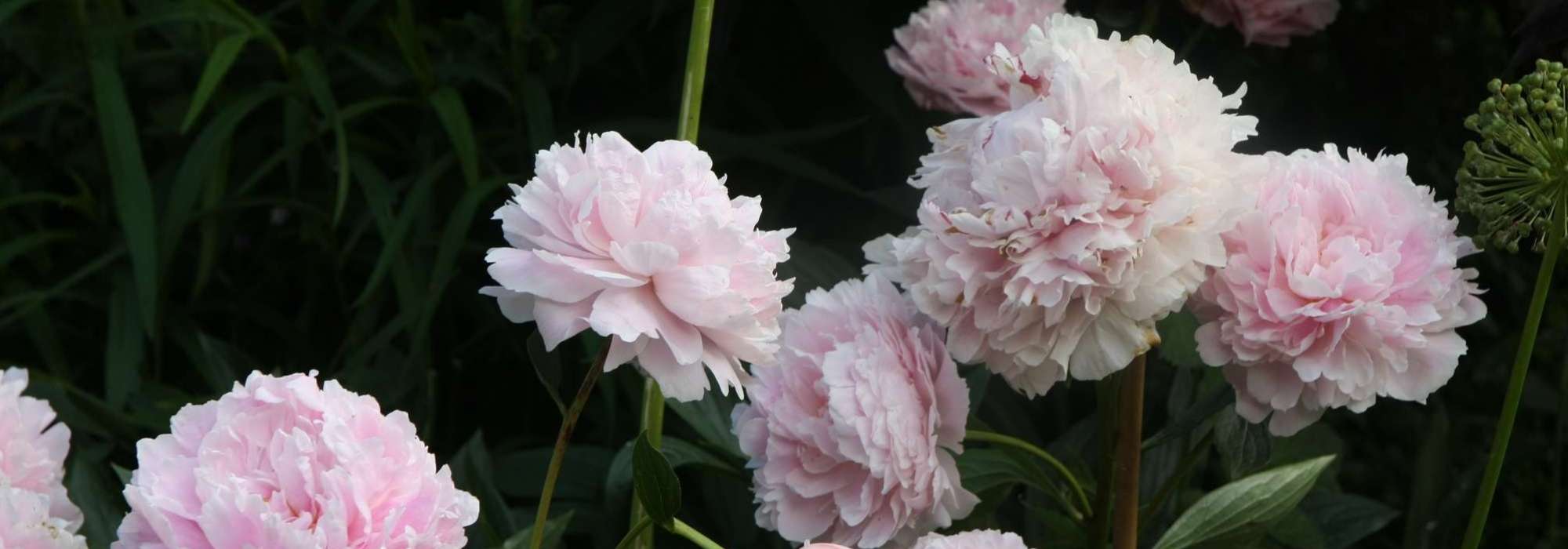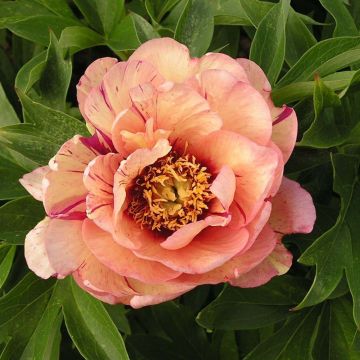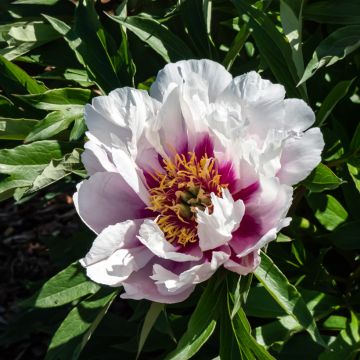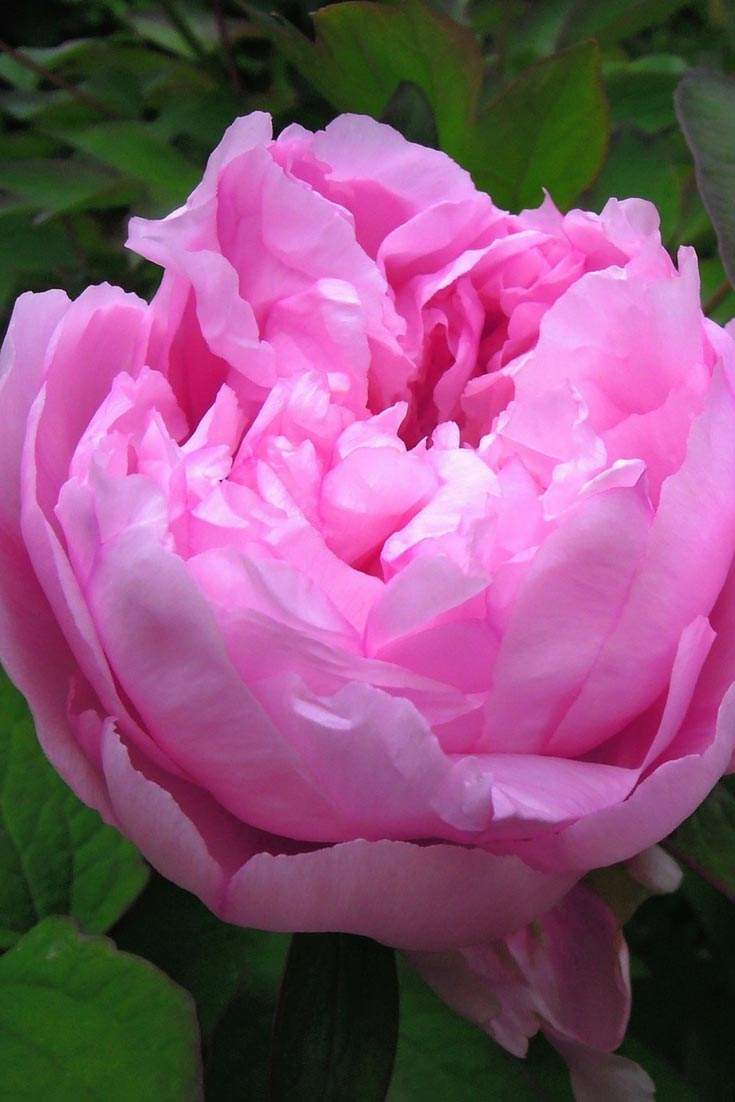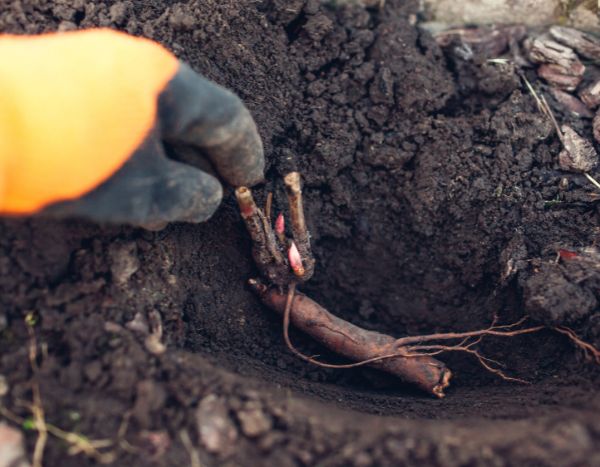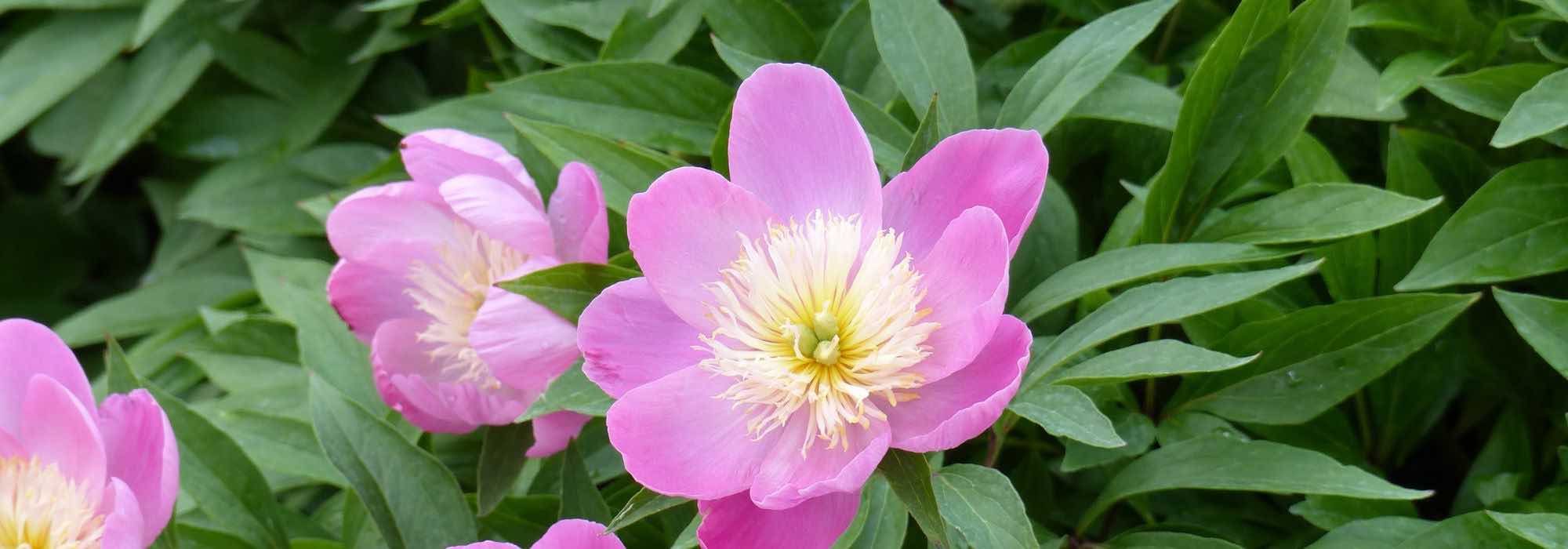

Paeonia itoh Yellow Crown


Paeonia itoh Yellow Crown


Paeonia itoh Yellow Crown


Paeonia itoh Yellow Crown


Paeonia itoh Yellow Crown


Paeonia itoh Yellow Crown


Paeonia itoh Yellow Crown


Paeonia itoh Yellow Crown
Paeonia itoh Yellow Crown
Paeonia x Itoh Yellow Crown
Itoh Peony, Intersectional Peony
Special offer!
Receive a €20 voucher for any order over €90 (excluding delivery costs, credit notes, and plastic-free options)!
1- Add your favorite plants to your cart.
2- Once you have reached €90, confirm your order (you can even choose the delivery date!).
3- As soon as your order is shipped, you will receive an email containing your voucher code, valid for 3 months (90 days).
Your voucher is unique and can only be used once, for any order with a minimum value of €20, excluding delivery costs.
Can be combined with other current offers, non-divisible and non-refundable.
Home or relay delivery (depending on size and destination)
Schedule delivery date,
and select date in basket
This plant carries a 12 months recovery warranty
More information
We guarantee the quality of our plants for a full growing cycle, and will replace at our expense any plant that fails to recover under normal climatic and planting conditions.
Would this plant suit my garden?
Set up your Plantfit profile →
Description
The Yellow Crown Itoh Peony (Paeonia x itoh) is a sought-after intersectional peony known for its incredible flowering, attracting all the attention in spring. It is a hybrid variety, resulting from cross-breeding between a tree peony and an herbaceous peony. In May-June it produces a large number of semi-double flowers, slightly fragrant, composed of bright yellow petals, with a satin-like appearance, slightly crumpled, enclosing a heart filled with golden yellow stamens. Dominating the foliage, the flowers rise on rigid stems, giving a graceful appearance to the flowering and offering beautiful blooms for cut flower arrangements.
The Yellow Crown Itoh Peony belongs to the Ranunculaceae or Paeoniaceae family. Itoh Peonies, or intersectional peonies, are the result of cross-breeding between a tree peony and an herbaceous peony. These plants are the result of the work carried out, starting in 1948, by the Japanese breeder Toichi Itoh, who was based in Tokyo and gave them his name. On his death in 1956 his widow passed on 6 varieties, including the Yellow Crown, to Louis Smirnov, an American of Russian origin who registered it with the American Peony Society in 1974. These plants, also known as intersectional, are exceptional perennials that combine the qualities of herbaceous and tree peonies, combining the vigour of herbaceous plants with all the splendour of tree species, in terms of both their foliage and their flowering.
The Yellow Crown Peony forms, from spring onwards, a compact and bushy herbaceous clump, reaching 90 cm (35in) in height and 100 cm (39in) in spread. Its growth is rather slow, but still faster than that of tree peonies. The plant develops large compound leaves with dark green and pointed leaflets that resemble those of tree peonies. Flowering takes place in early May in southern regions, a little later in cooler climates, abundantly and lasting for three weeks. Leafy, semi-rigid, very firm stems appear, carrying large buds at their tips that open into large solitary, semi-double flowers, 15 to 18 cm (6 to 7in) in diameter. They are composed of bright yellow petals, with a satin-like appearance, slightly crumpled, enclosing a heart filled with golden yellow stamens. The above-ground vegetation completely disappears in winter, remaining as buds (eyes) located on the surface of the soil. It re-emerges in March-April. It is a very long-lived plant. Itoh peonies dislike heavy, waterlogged soils, especially in winter, and appreciate semi-shaded locations such as the edge of a grove or the shelter of a hedge.
The hybrid Yellow Crown peony can be planted in flowerbeds or alongside a path, combined with timeless perennials such as dark blue Irises, columbines, campanulas, perennial geraniums, carnations, Christmas roses, or in association with shrub beds or roses. It can also be grown in the vegetable garden to supply cut flowers for the house. Growing it in a pot is not recommended as its needs will not be met.
In the Peony or Paeonia category, the Itoh peonies stand out for the duration of their flowering and the aesthetics of their flowers. Popular and appreciated for their many qualities, peonies find their rightful place in the garden and in the creation of bouquets or floral arrangements. With a very wide range of varieties, it is easy to find the one that best suits your desires.
Paeonia itoh Yellow Crown in pictures


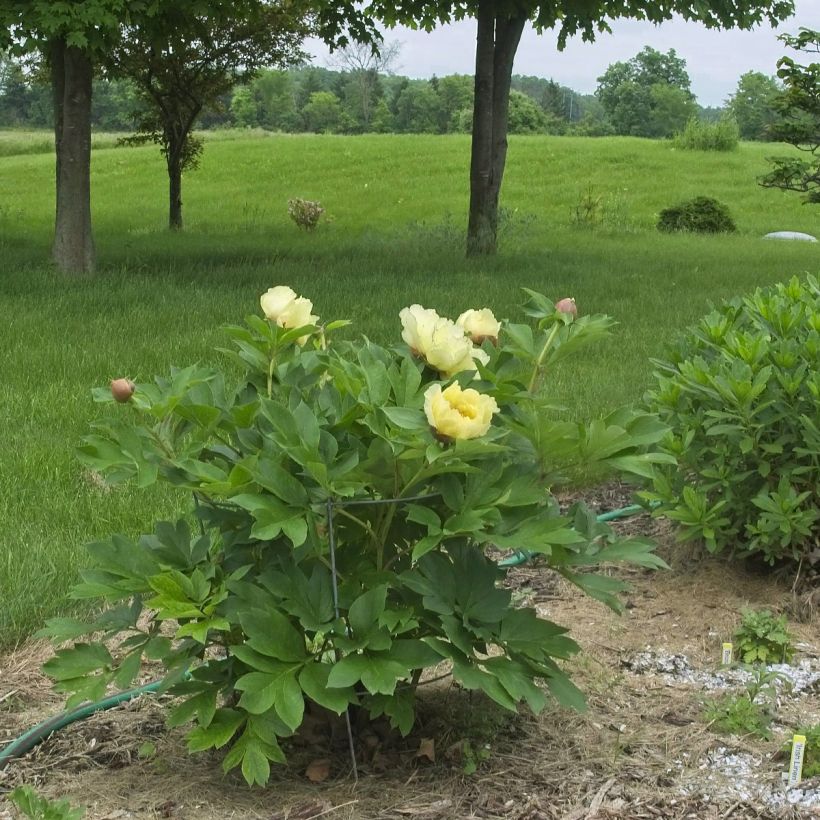

Flowering
Foliage
Plant habit
Botanical data
Paeonia
x Itoh
Yellow Crown
Ranunculaceae
Itoh Peony, Intersectional Peony
Cultivar or hybrid
Other Itoh Peonies - intersectional Peonies
View all →Planting and care
The Yellow Crown Itoh Peony should be planted from mid-September to April, leaving a spacing of 80 cm (32in), in fertile, deep, loose, humus-rich, moist, and well-drained soil. Choose a sunny but not scorching site, preferably in partial shade in warmer southern regions. Herbaceous peonies should not be buried more than 3cm (1in) deep, otherwise they will take several years to bloom again. Avoid permanent mulching as it can cause diseases, and apply rose fertiliser or compost in March.
Watering: the plant particularly needs water before and after flowering. In case of intense and prolonged drought, watering every 10 days will be sufficient (20 litres per plant).
Pruning is unnecessary, but remove faded flowers and damaged parts to prevent fungal diseases. Divide old clumps in autumn only if the plant becomes overcrowded. Be careful, as it has delicate roots and dislikes being moved; following this operation it may not flower for several years. Cut the foliage to ground level between February and April or October and November. Provide a support stake for the flower stems.
Planting period
Intended location
Care
Planting & care advice
This item has not been reviewed yet - be the first to leave a review about it.
Similar products
Haven't found what you were looking for?
Hardiness is the lowest winter temperature a plant can endure without suffering serious damage or even dying. However, hardiness is affected by location (a sheltered area, such as a patio), protection (winter cover) and soil type (hardiness is improved by well-drained soil).

Photo Sharing Terms & Conditions
In order to encourage gardeners to interact and share their experiences, Promesse de fleurs offers various media enabling content to be uploaded onto its Site - in particular via the ‘Photo sharing’ module.
The User agrees to refrain from:
- Posting any content that is illegal, prejudicial, insulting, racist, inciteful to hatred, revisionist, contrary to public decency, that infringes on privacy or on the privacy rights of third parties, in particular the publicity rights of persons and goods, intellectual property rights, or the right to privacy.
- Submitting content on behalf of a third party;
- Impersonate the identity of a third party and/or publish any personal information about a third party;
In general, the User undertakes to refrain from any unethical behaviour.
All Content (in particular text, comments, files, images, photos, videos, creative works, etc.), which may be subject to property or intellectual property rights, image or other private rights, shall remain the property of the User, subject to the limited rights granted by the terms of the licence granted by Promesse de fleurs as stated below. Users are at liberty to publish or not to publish such Content on the Site, notably via the ‘Photo Sharing’ facility, and accept that this Content shall be made public and freely accessible, notably on the Internet.
Users further acknowledge, undertake to have ,and guarantee that they hold all necessary rights and permissions to publish such material on the Site, in particular with regard to the legislation in force pertaining to any privacy, property, intellectual property, image, or contractual rights, or rights of any other nature. By publishing such Content on the Site, Users acknowledge accepting full liability as publishers of the Content within the meaning of the law, and grant Promesse de fleurs, free of charge, an inclusive, worldwide licence for the said Content for the entire duration of its publication, including all reproduction, representation, up/downloading, displaying, performing, transmission, and storage rights.
Users also grant permission for their name to be linked to the Content and accept that this link may not always be made available.
By engaging in posting material, Users consent to their Content becoming automatically accessible on the Internet, in particular on other sites and/or blogs and/or web pages of the Promesse de fleurs site, including in particular social pages and the Promesse de fleurs catalogue.
Users may secure the removal of entrusted content free of charge by issuing a simple request via our contact form.
The flowering period indicated on our website applies to countries and regions located in USDA zone 8 (France, the United Kingdom, Ireland, the Netherlands, etc.)
It will vary according to where you live:
- In zones 9 to 10 (Italy, Spain, Greece, etc.), flowering will occur about 2 to 4 weeks earlier.
- In zones 6 to 7 (Germany, Poland, Slovenia, and lower mountainous regions), flowering will be delayed by 2 to 3 weeks.
- In zone 5 (Central Europe, Scandinavia), blooming will be delayed by 3 to 5 weeks.
In temperate climates, pruning of spring-flowering shrubs (forsythia, spireas, etc.) should be done just after flowering.
Pruning of summer-flowering shrubs (Indian Lilac, Perovskia, etc.) can be done in winter or spring.
In cold regions as well as with frost-sensitive plants, avoid pruning too early when severe frosts may still occur.
The planting period indicated on our website applies to countries and regions located in USDA zone 8 (France, United Kingdom, Ireland, Netherlands).
It will vary according to where you live:
- In Mediterranean zones (Marseille, Madrid, Milan, etc.), autumn and winter are the best planting periods.
- In continental zones (Strasbourg, Munich, Vienna, etc.), delay planting by 2 to 3 weeks in spring and bring it forward by 2 to 4 weeks in autumn.
- In mountainous regions (the Alps, Pyrenees, Carpathians, etc.), it is best to plant in late spring (May-June) or late summer (August-September).
The harvesting period indicated on our website applies to countries and regions in USDA zone 8 (France, England, Ireland, the Netherlands).
In colder areas (Scandinavia, Poland, Austria...) fruit and vegetable harvests are likely to be delayed by 3-4 weeks.
In warmer areas (Italy, Spain, Greece, etc.), harvesting will probably take place earlier, depending on weather conditions.
The sowing periods indicated on our website apply to countries and regions within USDA Zone 8 (France, UK, Ireland, Netherlands).
In colder areas (Scandinavia, Poland, Austria...), delay any outdoor sowing by 3-4 weeks, or sow under glass.
In warmer climes (Italy, Spain, Greece, etc.), bring outdoor sowing forward by a few weeks.






























